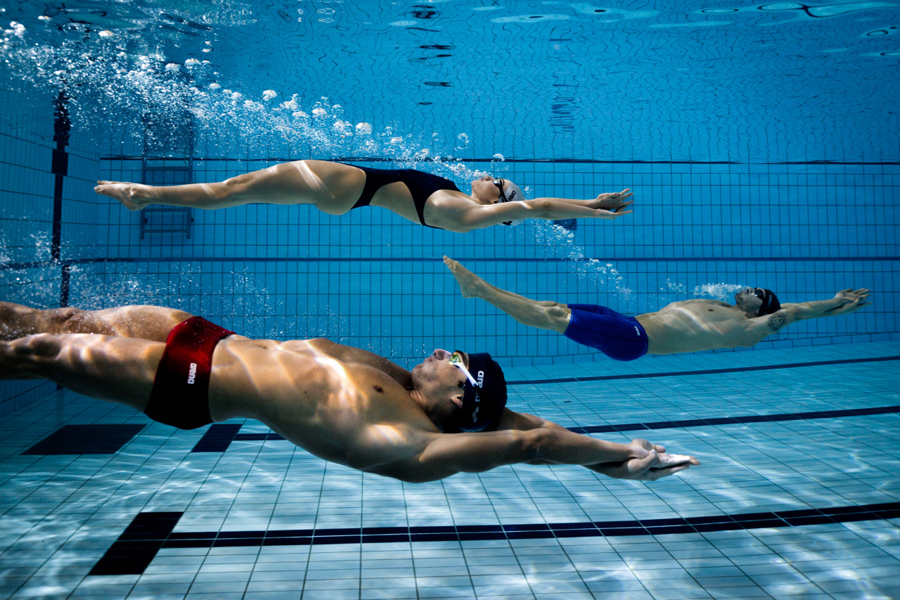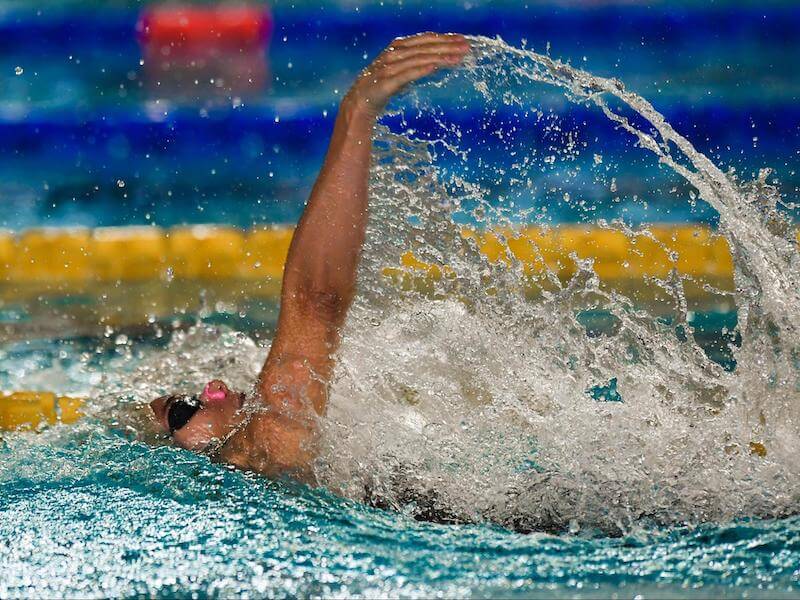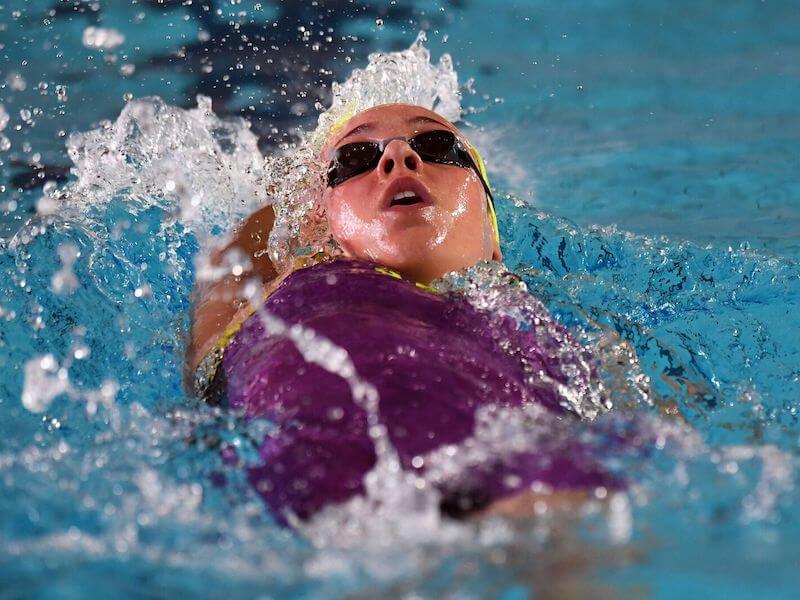10 Backstroke Drills for Your Next Practice
Backstroke is a unique swimming style that many people avoid due to the body position backstrokers must maintain. The stroke may seem very different from the popular front crawl stroke performed during freestyle swim events, but with knowledge of proper backstroke technique, plus backstroke drills for training, you can come a long way to improve your backstroke.
After reading this article, you will understand the fundamentals of how to swim backstroke. We will cover body position, body rotation, arm pull, kicking, and breathing techniques. Then, we will provide you with 10 backstroke drills for you to practice, each one including a short video so you can view the proper form used for the drill.
Focus On Good Body Position

Good swimming technique starts with excellent body position. The first step to developing good backstroke technique is to understand how your body should move through the water. Keeping proper body position during the backstroke drills will allow you to swim faster and longer because your body will be in a hydrodynamic position.
The appropriate body position for backstroke is to be nearly parallel with the surface of the water, with your legs pointing slightly downward to the bottom of the pool. The downward angle through your legs should be just enough to keep your feet from breaking the surface of the water while you kick. Do not let your hips drop too low, as this will cause unnecessary resistance as you move through the water.
Your neck and head position should be neutral so that you are looking upward. Do not look down toward your feet because this will cause discomfort in your neck muscles and create drag. Imagine that your head is resting in the water, somewhat like when you float on your back. Your ears should be right around the surface of the water to just underneath it.
Find the Right Amount of Body Rotation
You will want to rotate your shoulders and hips as you swim backstroke. Visualize yourself rotating around the line of your spine so that your hips and shoulders rotate in unison. Like swimming freestyle, the right amount of shoulder rotation will help you generate the necessary force through your arms to propel you through the water.
According to USA Swimming, the right amount of shoulder rotation is just under 30 degrees from the surface of the water. Make sure you do not rotate too much, as this will harm the efficiency of your stroke. Keep body rotation in mind as you perform your backstroke drills.
Concentrate on Arm Pull During the Backstroke Drills

The arm pull for backstrokers is somewhat different than the technique used in the front crawl stroke. It is essential to focus on the mechanics of your pull because this is where you will generate large amounts of force to propel you across the water.
When you take your stroke, your hand should enter the water with your little finger first. Your pinky should break the surface of the water on the same line that your shoulder is on.
As you begin to pull toward your thigh, your arm will start to bend. Now is when you start the power phase part of the stroke: Make sure your wrist and hand are open and facing toward the direction your feet are pointing. Begin to pull along the side of your body toward the outer part of your thigh. Focus on a strong and steady pulling motion all the way through to your leg.
Once your arm reaches your thigh, you will want to lift it straight up, leading with your thumb, out of the water to begin your arm recovery phase before taking your next stroke. Keep a straight arm through the recovery phase into your next stroke.
Focus on the way each arm moves through the water. It is natural for your body to have bilateral imbalances, so you will want to make sure that each arm performs the technique appropriately. The single-arm backstroke drill mentioned below is excellent for training one side of the body at a time.
Practice Your Backstroke Kick
A good backstroke kick can make or break the efficiency of your stroke. For backstroke swimming, you will use a flutter kick with the tops of your feet facing the surface of the pool rather than the bottom.
When you practice your backstroke drills, focus on your kick and the position of your feet relative to the surface of the water. One mistake many new backstrokers make is that their feet are too close to the surface. When this occurs, you run the risk of having the end of your kick finish outside the water, resulting in a loss of propulsive force.
Instead, you’ll want to ensure your feet are slightly angled down toward the bottom of the pool, as we mentioned above. This will guarantee that your kick will not break the water’s surface so that you can maximize the amount of water displaced with each kick.
Besides being aware of how you kick in the water, you will want to train your legs both in the pool and during dryland training.
In the pool, you should train your backstroke flutter kick with a kickboard when you practice the rest of your kick drills. Don’t just kick on your back though; train on your stomach and both sides as well to develop well-rounded strength in your legs.
On land, you should train your legs for strength and flexibility (be sure to consult your swim coach or another physical training professional before beginning new strength and flexibility routines).
Pay Attention to How You Breathe

Unlike other swimming strokes, your mouth and nose are always out of the water during backstroke. That does not mean you should try swimming with irregular breathing though. Try to regulate your breathing when you perform the backstroke drills below.
A good backstroke breathing pattern is to inhale as the right arm begins its entry into the water and to exhale when the left arm starts its entry into the water or vice versa, if you prefer. This breathing pattern will provide consistency during training and races.
10 Backstroke Drills for You to Practice
Here are some simple exercises that can improve your swim stroke with regular practice. Remember to perform each exercise at least twice with 15-20 seconds of rest between each lap.
1. Using a kickboard: Holding a kickboard in your hands with your arms extended and lying on your back, swap hands after every stroke. Perform four strokes holding the kickboard at hip height and four with it extended above your head.
2. One-arm drill: Swim the backstroke using just one arm, keeping the other alongside your body.
3. Breaststroke legs: Swim backstroke inserting a breaststroke leg kick at the end of each set of arm strokes (breathe in while moving your arms and breathe out during the leg kick).
4. Glass placed on your forehead: Swim backstroke with a glass placed right in the middle of your forehead, making sure it does not fall off.
5. Closed-fist drill: Swim the backstroke with your fists clenched.
6. Front crossovers: Take a short pause after every three arm strokes. Leave one arm at your side and the other extended behind your head. At this point, without your arms going underwater, switch your arm positioning using a semi-circle motion so that the arm by your side is now above your head and the arm above your head is now by your side. Repeat the action three times, so your original leading arm is now by your side. Repeat the steps from the beginning.
7. With a low pullbuoy: Swim the backstroke holding a pullbuoy between your knees.
8. Alternating: Pause for two seconds as one hand enters the water and wait for the other hand to come around. Continue your stroke and then kick with your arms at your sides before starting again.
9. Seated: Swim the backstroke attempting to adopt a seated position and keeping your arm cadence extremely high (perform this exercise for just a few seconds, alternating with the double-arm backstroke).
10. Swap over: Swim the backstroke with one arm holding a pullbuoy in front of your face. As your arm swings past, swap hands and continue your stroke using the hand that was holding the pullbuoy.
Keep Up the Good Work on Your Backstroke Drills
Now that you have some new swimming tips and drills to practice backstroke, you can get some laps at the pool. Once you feel like you have the hang of the backstroke swimming fundamentals, don’t forget to improve other areas of your backstroke, like starts and turns.
Remember to always focus on proper technique while you train. Keep in mind the appropriate body position during your backstroke drills: legs not too high and hips not too low. Rotate your shoulders and hips at just under 30 degrees, and make sure your arms are moving through the water with good form. Keep your breathing consistent and your kick strong. Do these things during all your backstroke drills and you are sure to see improvement.
Written by:
arena coaches
Swim coaches, trainers and experts will give you all kinds of tips for performing at your best in both training and races.







